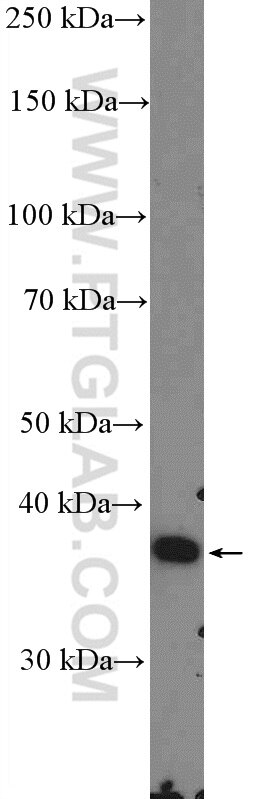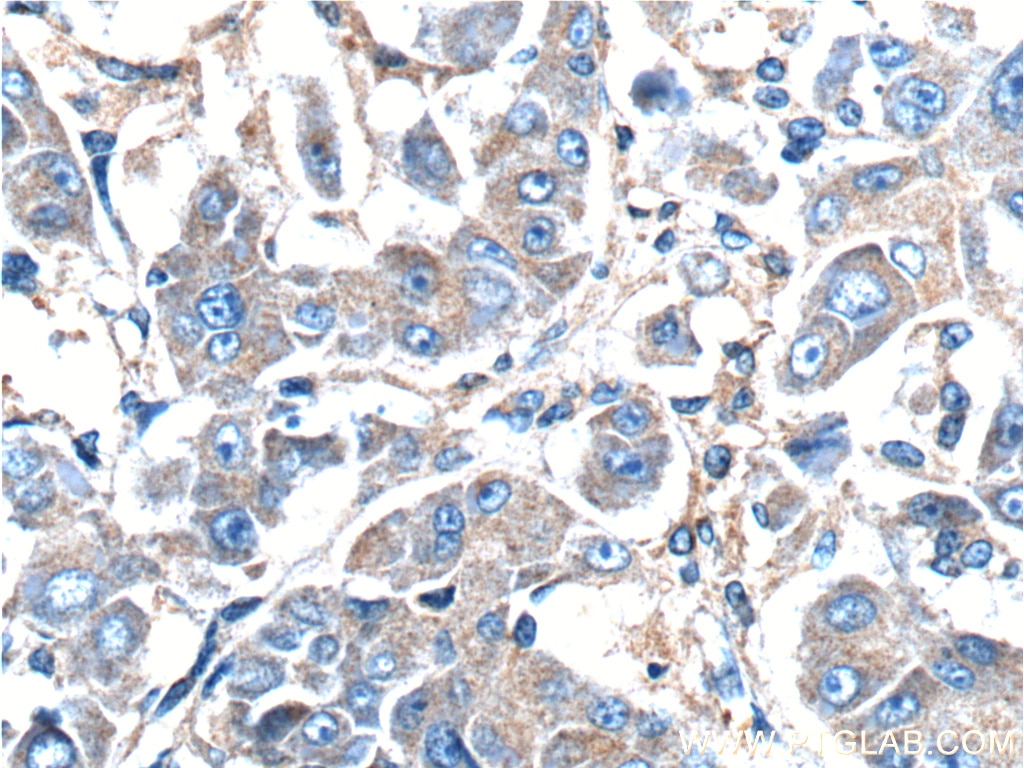GNB3 Polyklonaler Antikörper
GNB3 Polyklonal Antikörper für WB, IHC, IF/ICC, ELISA
Wirt / Isotyp
Kaninchen / IgG
Getestete Reaktivität
human, Maus, Ratte und mehr (1)
Anwendung
WB, IHC, IF/ICC, ELISA
Konjugation
Unkonjugiert
Kat-Nr. : 10081-1-AP
Synonyme
Galerie der Validierungsdaten
Geprüfte Anwendungen
| Erfolgreiche Detektion in WB | Maushirngewebe, Maus-Augengewebe, Maus-Cerebellum-Gewebe, Mausembryogewebe, Rattenhirngewebe |
| Erfolgreiche Detektion in IHC | humanes Leberkarzinomgewebe Hinweis: Antigendemaskierung mit TE-Puffer pH 9,0 empfohlen. (*) Wahlweise kann die Antigendemaskierung auch mit Citratpuffer pH 6,0 erfolgen. |
| Erfolgreiche Detektion in IF/ICC | HepG2-Zellen |
Empfohlene Verdünnung
| Anwendung | Verdünnung |
|---|---|
| Western Blot (WB) | WB : 1:1000-1:6000 |
| Immunhistochemie (IHC) | IHC : 1:100-1:400 |
| Immunfluoreszenz (IF)/ICC | IF/ICC : 1:20-1:200 |
| It is recommended that this reagent should be titrated in each testing system to obtain optimal results. | |
| Sample-dependent, check data in validation data gallery | |
Veröffentlichte Anwendungen
| WB | See 5 publications below |
| IF | See 2 publications below |
Produktinformation
10081-1-AP bindet in WB, IHC, IF/ICC, ELISA GNB3 und zeigt Reaktivität mit human, Maus, Ratten
| Getestete Reaktivität | human, Maus, Ratte |
| In Publikationen genannte Reaktivität | human, Maus, Ratte, Zebrafisch |
| Wirt / Isotyp | Kaninchen / IgG |
| Klonalität | Polyklonal |
| Typ | Antikörper |
| Immunogen | GNB3 fusion protein Ag0127 |
| Vollständiger Name | guanine nucleotide binding protein (G protein), beta polypeptide 3 |
| Berechnetes Molekulargewicht | 37 kDa |
| Beobachtetes Molekulargewicht | 35-37 kDa |
| GenBank-Zugangsnummer | BC000115 |
| Gene symbol | GNB3 |
| Gene ID (NCBI) | 2784 |
| Konjugation | Unkonjugiert |
| Form | Liquid |
| Reinigungsmethode | Antigen-Affinitätsreinigung |
| Lagerungspuffer | PBS mit 0.02% Natriumazid und 50% Glycerin pH 7.3. |
| Lagerungsbedingungen | Bei -20°C lagern. Nach dem Versand ein Jahr lang stabil Aliquotieren ist bei -20oC Lagerung nicht notwendig. 20ul Größen enthalten 0,1% BSA. |
Hintergrundinformationen
Guanine nucleotide-binding proteins (g proteins) are involved as a modulator or transducer in various transmembrane signaling systems, by integrating signals between receptors and effector proteins. G proteins are composed of an alpha, a beta, and a gamma subunit. This gene encodes a 34 kd beta subunit, being expressed in all tissues. Beta subunits are important regulators of alpha subunits, as well as of certain signal transduction receptors and effectors.
Protokolle
| Produktspezifische Protokolle | |
|---|---|
| WB protocol for GNB3 antibody 10081-1-AP | Protokoll herunterladen |
| IHC protocol for GNB3 antibody 10081-1-AP | Protokoll herunterladen |
| IF protocol for GNB3 antibody 10081-1-AP | Protokoll herunterladen |
| Standard-Protokolle | |
|---|---|
| Klicken Sie hier, um unsere Standardprotokolle anzuzeigen |
Publikationen
| Species | Application | Title |
|---|---|---|
Neuron Sustained antidepressant effects of ketamine metabolite involve GABAergic inhibition-mediated molecular dynamics in aPVT glutamatergic neurons | ||
Elife Injury-induced pulmonary tuft cells are heterogenous, arise independent of key Type 2 cytokines, and are dispensable for dysplastic repair | ||
Hum Mol Genet CERKL gene knockout disturbs photoreceptor outer segment phagocytosis and causes rod-cone dystrophy in zebrafish. | ||
J Biol Chem Pathogenic Mutations in Retinitis Pigmentosa 2 Predominantly Result in Loss of RP2 Protein Stability in Human and Zebrafish. | ||
Sci Rep PET-CT and RNA sequencing reveal novel targets for acupuncture-induced lowering of blood pressure in spontaneously hypertensive rats. | ||







